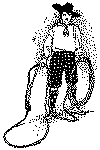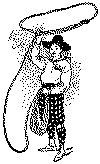By Dan Beard

Fig. 343.
Properly speaking, there is no such thing as a "lasso." You may lasso things with lariat, but you cannot carry a " lasso," because lasso is a verb, and no cowboy carries a verb coiled at his saddle-bow though he may have strings of forcible adjectives under his tongue.
The American cowboy learned the use of la riata from the Mexican, and he shortened the name and called it lariat, which has become the accepted name among Americans. This cowboy calls it lass-rope or simply rope, and when he lassos a steer he says he " roped it."
Boys' books are full of accounts and rules for archery and cricket, both of which are essentially English sports and have never become thoroughly naturalized in this country, but the graceful and useful art of throwing the lariat has never received the attention it deserves or been seriously adopted as a sport by our boys. Many of them, however, after visiting the Wild West show have played cow-boy, and with a bit of old clothes-line have made awkward efforts to lasso their comrades, who, it is presumed, represented the buffalo of the Wild West.
The very best lariats are made of raw hides. On Rose bud River there lives, or formerly lived, a half-breed who was so skilful a workman that he could with propriety be called a lariat artist. One of the raw-hide ropes that he made I have in my studio, and it is admired by every cattleman who chances to see it.
How the Rawhide Lariat is Made.
The raw hide is first cut into strips as long as the hide will allow. The hide is half- tanned without removing the hair. The strips are next soaked in water and stretched over a block, after which they are neatly braided into a rope. During the latter process they are care- fully pulled as tight as possible. When this is done the rope is buried in the ground and al- lowed to remain in the earth two weeks to soften, after which it is dug up and again stretched over a block by means of heavy weights. After the hair has been sand- papered off, the rope thoroughly oiled or greased with mutton tallow and properly noosed, it is ready for use.
The lariats are made either forty or fifty feet long, ac- cording to the preference of the maker. Mr. Charles Lummis says the standard lariat is forty feet in length, but from other sources I learn that there are two standards, one of fifty and one of forty feet. The lariats vary also in thickness from three-eighths of an inch to half an inch. It takes a hardy, tough man to wield one of such dimensions. A rope twenty or thirty feet long is long enough for any boy to handle.
How to Make a Boy's Lariat.
A small iron ring, or eyelet, such as is used on sails and awnings, may be obtained at the hardware shop for a few cents. One end of the small rope, selected for the lariat, must now be unraveled, and the loose ends brought care- fully around the ring from opposite directions, meeting again at the unwound part of the rope. Here they must lie neatly upon each side of the rope, bound tightly in place with a strong piece of twine.

Figs. 355-364.
The other end of the rope should be wound in the same manner to prevent it from unraveling. This will make as good a lariat as that used by many an expert cowboy. In certain parts of the country this form of "lass rope" is used exclusively. Of course when a boy becomes an expert he will be ambitious to have a rawhide rope.
There is also a braided linen line that is very good. But the homemade rope will answer all boyish purposes and afford him more pleasure than the heavy rawhide "wolly " Western one can.
How to Throw the Rope
Mr. Lummis recommends a loop of seven feet diameter to begin with, while the expert, Mr. Louis Ohnimus, starts with a noose only a foot or a foot and one-half in diameter, allowing the rope to slip and the noose to grow larger as he swings it; but most of my rope-throwing friends advise the large loop.
Take your position in front of a target, a post for instance. Run the end of the rope through the ring or "honda," as it is called. Coil the rope in your left hand, carefully leaving about six feet of loose rope between the coil and the noose, and see that there are no kinks in the line and that the coils will slip easily off when the noose is thrown (Fig. 343). Take hold of the noose with your right hand about a foot from the ring, and with the same hand grasp the rope the same distance below the ring or honda (pronounced onda) (Fig. 343).

Fig. 343.
Do not hold your wrist stiffly, but allow it to move easily as you swing the noose over your head from right to left (Fig. 344). Let your wrist act as an axle, and swing the rope as if it were a wheel revolving horizontally around your wrist and over your head.

Fig. 344.
Let it move with sufficient force to lengthen the noose, if you use the small noose, and swift enough to enable you to guide it if you have started with a large noose. When you feel that the proper time has arrived for making the cast, choose the moment as your swinging hand comes around from back to front, give a quick step forward, bring your hand, with palm down, forward and down to the level of your shoulder, let it stretch to a full arm's- length without interrupting the swinging motion of the noose, and let it go at the post (Fig. 345).
In throwing the rope the right side of the loop should be lower than the other; then this side will strike first and throw the other side over the object.
If you have followed these rules without a slip it will not be a bad throw even though it is your first, and if you failed to circle the post you at least saw the noose sail straight at it without losing its circular form, and this will encourage you to try again and again until the poor post will become red in the face from the choking it receives.
First strive to send the noose sailing on a level course. When this is achieved more than half the battle is won, and you can begin to teach your playmates this sport. Besides being typically American and great as an educator of the eye and developer of the muscles, it may be an exceedingly useful acquisition to a boy's list of accomplishments. Many a life of skater and swimmer has been lost that would have been saved had any of the panic-stricken spectators been able to cast a rope with even a small degree of accuracy.
The Lariat on Horseback
Here you do not coil the rope, for it is ready coiled at your saddle-bow. The loop, however, when the rope is coiled at your saddle-bow is only the size of the fakes, or coil-loops; so the noose must be lengthened. You simply lift the rope from the saddle, and throw as described. The lariat is not made fast to the horn of the saddle, because that is exceedingly dangerous. A big bull, steer, horse, or some of the smaller animals, when improperly roped, can throw horse and man. When the strain comes the rider makes a hitch over the saddle horn that will hold if necessary, or that he can cast loose if the occasion demands. A cow-puncher who ties the riata to the saddle-horn is looked upon with scorn by his more proficient neighbors. The end of the rope should be held loosely in the left hand until the animal is caught, and then a couple of quick turns are taken with it around the saddle-horn.
Said a Western friend to me, "In roping from your horse the horse is trained to brace back as the rope tightens. In roping a cow or a steer the forefoot is always the target, never the head. All you have to do," he continued, " is to throw the rope in front of the beast so that the side of the noose nearest the cow is on the ground and the other side in the air. Then the animal will step right into it. See?" I saw and tried it many times. It can be done after practice, no doubt, for cow-boys do it, but it is not so easy as it sounds.